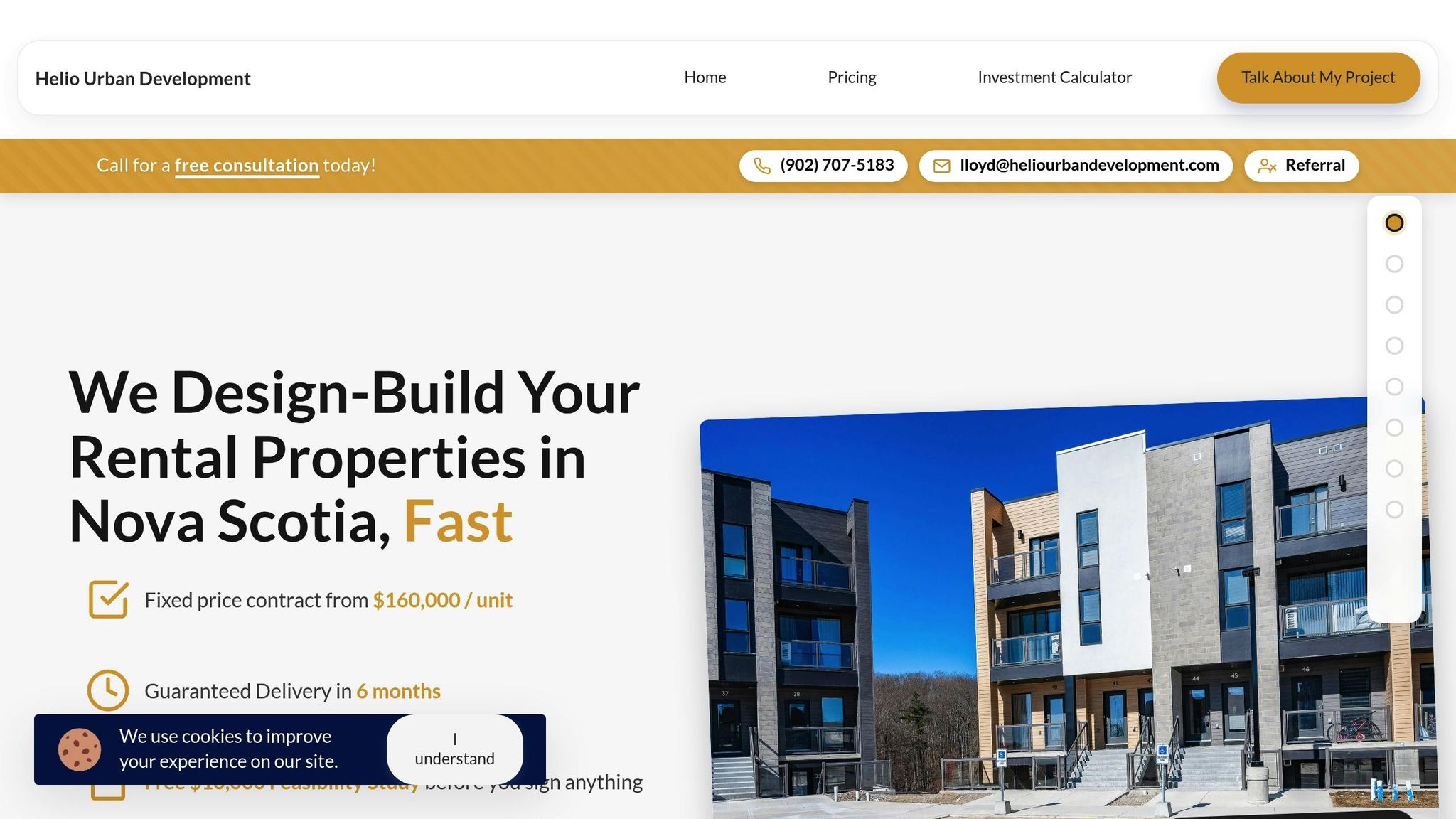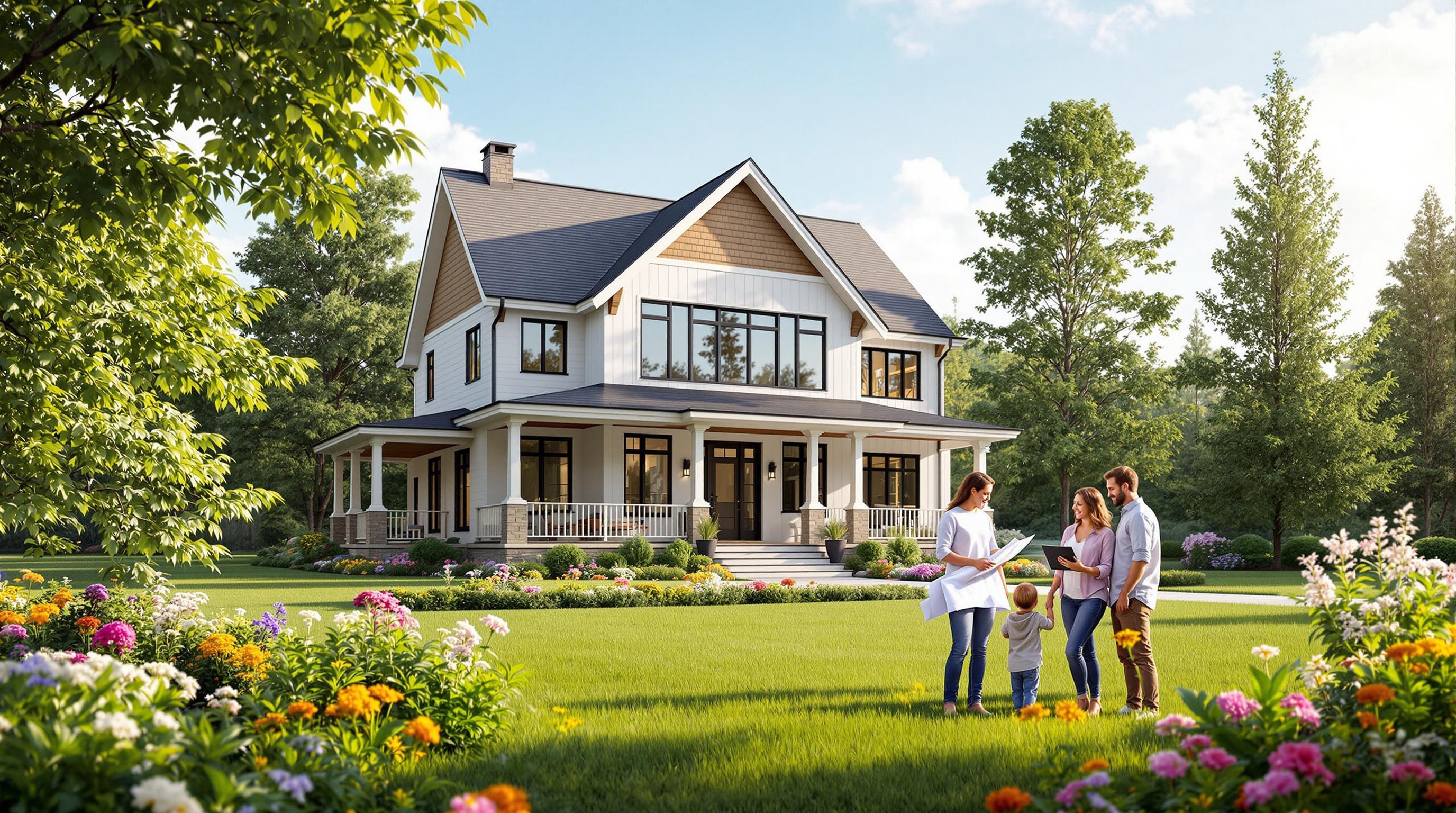When building rental properties in Nova Scotia, your first decision is choosing between pre-designed plans and custom designs. Here's what you need to know:
- Pre-designed plans: Faster, cost-effective, and optimized for predictable rental income. These plans are pre-approved for local codes, reducing permitting delays and construction costs. However, they offer limited flexibility and may not suit unique lot conditions or specialized tenant needs.
- Custom designs: Tailored to specific site conditions and market demands, offering greater flexibility and potential for higher rents. But they come with longer timelines, higher upfront costs, and more coordination challenges.
Key Considerations:
- Budget: Pre-designed plans cost less upfront, with fixed pricing at $160,000/unit. Custom designs often face cost overruns of 30–60%.
- Timeline: Pre-designed projects finish in 8–10 months, while custom designs can take 18–24 months.
- Market Fit: Pre-designed layouts appeal broadly, while custom designs target niche preferences.
- Permitting: Pre-designed plans are faster to approve, while custom designs require detailed reviews.
Quick Comparison:
| Factor | Pre-Designed Plans | Custom Design |
|---|---|---|
| Cost | Lower, fixed pricing | Higher, with potential overruns |
| Timeline | 8–10 months | 18–24 months |
| Design Flexibility | Limited | Fully customizable |
| Market Appeal | Broad | Niche-focused |
| Permitting | Faster | Slower |
Pro Tip: For efficiency and cost control, consider an integrated design-build approach, where all professionals work together under one contract. This reduces delays, miscommunication, and budget issues.
Buying Pre-Made Floor Plans vs. Investing in An Architect or Draftsman
Pre-Designed Plans: Benefits and Limitations
Pre-designed plans provide a practical and efficient solution for constructing multi-unit properties in Nova Scotia. These plans are based on designs that have already been used successfully in similar rental markets, giving you the confidence of working with layouts that are proven to perform.
By addressing some of the challenges associated with fragmented construction, pre-designed plans come with clear advantages while also presenting a few limitations.
Benefits of Pre-Designed Plans
Quicker project timelines:
With pre-designed plans, the permitting process moves faster, cutting down the design phase and speeding up construction. This means rental income can start flowing sooner.
Reduced upfront design costs:
You can save money by skipping the need for custom architectural and engineering services.
Streamlined permitting process:
Municipalities, especially in smaller communities, are familiar with these standard plans, which often results in quicker reviews and approvals.
Predictable construction costs:
Contractors experienced with these designs can work more efficiently and provide accurate cost estimates. This familiarity helps avoid unexpected expenses that can arise with more fragmented construction methods.
Proven tenant appeal:
These layouts are designed to attract renters and have a track record of success in similar markets.
Limitations of Pre-Designed Plans
Limited customisation options:
Standard designs may not adapt well to unusual lot shapes or site-specific challenges.
Challenges with unique site conditions:
Pre-designed plans assume standard lot conditions. Issues like rocky terrain, wetlands, or unusual utility setups might require additional, expensive modifications.
Lack of market differentiation:
Using the same designs across multiple properties in an area can make units feel repetitive, potentially limiting the ability to charge premium rents.
Potential mismatches with local demand:
The included features might not align perfectly with what the local market values, leading to over- or under-delivering on tenant expectations.
Restricted flexibility for future updates:
These plans might not allow for easy upgrades or changes if tenant preferences evolve over time.
Carefully consider these benefits and limitations to determine if pre-designed plans align with your project’s goals. This evaluation will also help you weigh them against custom design options as you move forward.
Custom Design: Benefits and Drawbacks
Custom design tailors multi-unit projects to meet specific site conditions and investment goals. Unlike the integrated design-build approach, it requires managing separate architects, engineers, and contractors, which can add complexity.
This method works well for properties with unique characteristics or for owners looking to make the most of every square metre. However, it comes with trade-offs, including longer timelines and higher budgets. While the benefits can be compelling, the drawbacks need careful consideration.
Benefits of Custom Design
Making the most of your property:
Custom designs adapt to irregular lot shapes, steep slopes, or other challenging site conditions that standard plans might not handle well. This leads to more efficient use of space and attractive layouts.
Standing out in the market:
A custom property offers something different from the usual rental options. This uniqueness can justify higher rents and attract tenants looking for something special.
Meeting local needs:
Custom designs allow for features that cater to specific market demands, like home offices or larger kitchens, making the property more appealing to local tenants.
Planning for the future:
Designing with future changes in mind - such as adding extra electrical capacity or using flexible wall systems - makes renovations or upgrades easier down the line.
Boosting rental potential:
By tailoring the property to local preferences, custom designs can help improve rental performance and make the property more competitive.
Drawbacks of Custom Design
Higher upfront expenses:
Custom designs come with additional architectural and engineering fees, increasing the initial investment compared to using standard plans.
Longer timelines:
The design phase can take months, and permitting and construction may stretch far beyond the timelines of standard projects.
More coordination required:
Managing multiple specialists can lead to miscommunication and delays, adding complexity to the process.
Cost uncertainties:
Custom projects often lead to higher contractor quotes and are prone to cost overruns, unlike fixed-price integrated designs.
Potential design issues:
Unproven layouts may not work as intended, potentially causing maintenance headaches or failing to appeal to tenants.
Specialized contractor needs:
Some contractors may lack experience with custom designs, requiring skilled tradespeople who understand unconventional methods. This can lead to longer construction times and higher labour costs.
Choosing a custom design means balancing these advantages and challenges to decide if this approach aligns with your project’s goals and budget.
sbb-itb-16b8a48
Pre-Designed Plans vs Custom Design: Side-by-Side Comparison
Deciding between pre-designed plans and custom design influences your project’s timeline, budget, and potential rental income. Here’s a detailed breakdown to help you make an informed choice.
Key Comparison Factors
Costs involve more than just the initial design fees. Pre-designed plans include design costs within the fixed construction price, sparing you additional architectural expenses. On the other hand, custom designs require hiring architects and engineers separately, resulting in higher upfront costs.
Timelines differ significantly. Pre-designed plans allow for a faster transition from permits to construction, often wrapping up in about six months. Custom designs, however, demand months of planning and design work before construction can even begin, extending the overall schedule.
Flexibility in design is a major trade-off. Pre-designed plans feature layouts optimized for rental income but offer limited options for customization. Custom designs give you the freedom to adapt layouts to specific site conditions or niche markets, though this requires coordination with multiple professionals.
Permitting and compliance processes also vary. Pre-designed plans are pre-approved for Nova Scotia building codes, speeding up the approval process. Custom designs, however, must undergo a detailed individual review, which can delay progress.
Market performance is another critical factor. Pre-designed plans rely on tried-and-tested layouts that appeal to a broad range of tenants, often delivering predictable annual returns between 12% and 20%. Custom designs can cater to specific market needs but may not always guarantee consistent rental performance.
Comparison Table
| Factor | Pre-Designed Plans | Custom Design |
|---|---|---|
| Upfront Design Cost | Minimal - design fees included in construction | Higher - additional architectural fees apply |
| Construction Timeline | 6 months guaranteed | 12–18 months typical |
| Total Project Timeline | Approximately 8–10 months from start | Around 18–24 months from start |
| Cost Certainty | Fixed-price construction at $160,000/unit | Cost-plus model with potential overruns of 30–60% |
| Design Flexibility | Limited to pre-approved variations | Fully customizable |
| Site Adaptability | Best for standard lots | Ideal for irregular or challenging sites |
| Permitting Process | Pre-verified for Nova Scotia codes; faster approval | Requires individual review |
| Coordination Complexity | Managed by a single integrated team | Involves multiple independent professionals |
| Rental Market Appeal | Proven layouts with broad appeal | Tailored to specific preferences |
| Quality Assurance | Tested designs with a 2-year warranty | Quality depends on the design and execution |
| ROI Predictability | Around 12–20% annual ROI | Returns vary depending on design effectiveness |
This side-by-side comparison highlights why pre-designed plans are often favoured for their predictability and efficiency, while custom designs are better suited for unique or highly specific projects. The choice ultimately depends on your investment strategy and project timeline.
How to Choose the Right Design Approach for Your Nova Scotia Property
Factors to Consider When Deciding
The goals of your project should guide your choice of design. If you're aiming to build rental properties with steady returns, pre-designed plans are often a safer bet. These plans are carefully crafted to balance layouts that boost rental income while keeping construction costs under control. However, if your property has unique site conditions or you're catering to a specific tenant group, custom designs can provide the flexibility you need.
Budget considerations are another key factor. In Nova Scotia, traditional construction methods typically lead to budget overruns ranging from 30% to 60%. For instance, coordination issues can add over $47,000 to the cost of a fourplex. Pre-designed plans, combined with fixed-price construction, help avoid these pitfalls by locking in costs before construction begins. Custom designs, on the other hand, often require separate payments to architects, engineers, and other specialists. They may also rely on cost-plus contracts, which leave you responsible for any overruns.
Your timeline is equally important. Delays in construction can quickly add up, with property owners potentially losing around $8,800 in rental income for every month a fourplex remains unfinished. Pre-designed plans generally allow projects to move from permits to completion in about six months. In contrast, custom designs can stretch timelines significantly, often taking 8 to 18 months or more due to coordination and permitting hurdles.
The local rental market in your area of Nova Scotia should also influence your decision. In well-established rental markets, pre-designed plans with proven layouts tend to attract a broad range of tenants. However, in emerging or niche markets, custom designs might be better suited to meet specific tenant preferences or market demands. When combined with your budget and timeline, these market dynamics help form a comprehensive decision-making framework.
How Helio Urban Development Simplifies Design and Construction

Once you've clarified your design needs, a streamlined approach can save you time, money, and stress. Helio Urban Development offers an integrated design-build model tailored for 4+ unit rental properties. Instead of juggling separate architects, engineers, and contractors, Helio brings all these experts together from the start, eliminating the miscommunication and delays that often plague traditional construction.
This approach tackles three major challenges: it simplifies coordination, locks in pricing at $160,000 per unit to avoid budget overruns, and ensures a six-month completion timeline, backed by penalties of up to $1,000 per day for delays.
Helio also keeps owners informed with daily photo updates via a real-time portal. A triple quality-check system includes five inspections by professional engineers during construction, with the final inspection selected by the owner to guarantee top-tier results.
Helio was founded by Lloyd Liu, a former Merrill Lynch banker who has overseen more than $30 million in projects, and Yuan He, a data scientist from the University of Pennsylvania. Their advanced scheduling systems help prevent the kinds of delays often seen in traditional construction.
Currently, Helio has 31 units under construction and 131 more in the planning stages across Nova Scotia. Serving property owners within a 90-minute radius of Halifax, Helio's clients typically achieve monthly rents of $1,950–$2,100 per unit and annual returns of 12–20%. This shifts the focus from managing risks to maximizing returns.
Conclusion: Selecting the Best Design Approach for Your Rental Property
When deciding on a design for your rental property, think about your specific goals. Pre-designed plans are ideal if you're looking for predictable costs and faster completion, which can help you start generating income sooner. On the other hand, custom designs cater to unique requirements but often come with higher expenses and longer timelines.
It's also important to consider how the construction process impacts your project. Choosing a fragmented construction approach - where different contractors handle separate tasks - can lead to delays and budget overruns. Opting for a design-build model, where all professionals work together under a single contract, can streamline the process and improve efficiency. This method works well with both pre-designed and custom plans, helping you avoid unnecessary delays. After all, every extra month spent on construction is time you're not earning rental income.
FAQs
How do I decide between pre-designed plans and custom designs for rental properties in Nova Scotia?
When deciding between pre-designed plans and custom designs, it’s important to weigh factors like budget, timeline, and design flexibility. Pre-designed plans are usually easier on the wallet and can significantly speed up the construction process, often wrapping up in just 4–6 months. In contrast, custom designs tend to be more expensive and require a longer timeframe, often stretching to 9–12 months or more. However, they provide the freedom to adapt to unique land features, local climate conditions, and zoning rules specific to Nova Scotia.
Custom designs are a great choice if your project involves tricky site conditions or if you want to address specific environmental factors. Meanwhile, pre-designed plans are a practical option for simpler projects where cost and quick completion are the main priorities. Think about your project’s goals and consult with knowledgeable professionals to figure out which approach suits you best.
What are the benefits of using an integrated design-build approach for multi-unit rental properties in Nova Scotia?
The design-build approach simplifies the construction process by merging design and construction services into a single contract. This unified system creates one point of accountability, cutting down on risks, improving communication, and making decision-making much smoother throughout the project.
Because the design and construction phases overlap, projects often move faster, which can translate into savings. Early collaboration also helps spot and address potential issues, making the entire process more predictable and easier to manage. For multi-unit rental projects, this method stands out as a more efficient and coordinated alternative to traditional approaches that rely on separate contracts and step-by-step phases.
What challenges can arise with custom designs, and how can property owners address them effectively?
Custom designs in Nova Scotia come with their own set of hurdles. Unpredictable weather can throw off schedules, unique materials might face supply chain hiccups, and adapting designs to the local terrain and regulations can sometimes get tricky. If not carefully managed, these challenges could lead to higher costs or longer timelines.
To navigate these potential setbacks, start with detailed project planning and early risk assessments. Identifying issues ahead of time gives you a chance to tackle them before they escalate. It's also crucial to work with licensed contractors who have experience with Nova Scotia’s permitting processes and are familiar with the local site conditions. This kind of expertise can make a big difference in keeping things running smoothly. A proactive approach can help you avoid unnecessary delays and keep your project moving forward as planned.



